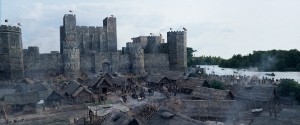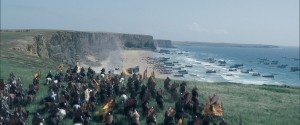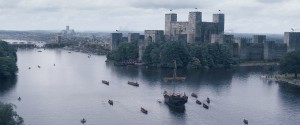For Robin Hood, director Ridley Scott’s take on the classic tale, MPC created hundreds of visual effects of medieval castles, an invading French armada, CG troops and many, many arrows. We talk to MPC visual effects supervisor Richard Stammers about his work for the film.

fxg: How did the work break down for MPC?
Stammers: MPC worked on 578 shots, although considerably less, 484, ended up in the film. There were 125 CG crowd army shots, 115 involving CG environment work, 75 with CG boats and 200 shots of digital arrows. We had a fairly large crew and I was assisted greatly by CG supervisor Max Wood and digital effects supervisor Jessica Norman.
fxg: The French armada shots seemed to combine a lot of different types of work. Can you talk about your approach to the whole battle sequence?
Stammers: Certainly our biggest chunk of work involved creating the French armada and the battle that ensues after they land on the beach. The actual French armada comprised about 200 boats. Ridley wanted a military-style landing where there would be waves of landing craft and row boats coming into the shore in stages. We set up a layout that he felt happy with and used that as a starting point for all of our shots.
Within those 200 boats, each was populated with French rowers, knights and soldiers and horses created using our proprietary ALICE (Artificial Life Crowd Engine) Maya-based software. For the actual actions of the boats landing and troops we would usually rely on our mocap library that we use within ALICE, but it had a limitation with the rowing action and horses disembarking. They’re quite specific movements, so we did a two day additional mocap shoot to add in the clips we needed to our ALICE software.
We got to the point where we had around 2000 soldiers on each side on the beach. Not everyone got to land on the beach because half of the landing was foiled by the English archers. The location that we shot at in Wales had a really good practical beach for the filming side, but from a tactical point of view, both Russell Crowe and Ridley felt we needed to add cliffs so that the English archers could have the opportunity to fire down on all the French troops and get an advantage.
Then there’s a calvary charge augmented with extra CG horses and riders as well. For the boats, production provided four landing craft and four row boats – so they certainly had to be augmented with other boats. We did have days where they had up to 500 extras on the beach, though, and that gave us some good in-camera reference for how the troops looked in the battle.
fxg: What were some of the challenges in surveying and tracking the beach location?
Stammers: The beach battle was shot over three weeks. Ridley’s shooting style is that he wants to have cameras everywhere. There were probably 10 cameras on the beach with a combination of main unit and second unit working together or separately on other days. There was also a helicopter unit that was doing aerial plates for wider shots. So it got pretty full-on. We were also dealing with a moving tide that was moving a metre per minute. So everything we had on the beach had to be moved really, really quickly. The entire crew were basically in 4X4s or little runabout gators. All the camera equipment had to be on something that could be moved quickly too, or even cameras on tripods ended up on little trolleys and moved back as the tide came in.
We had the same problem with any of our tracking markers. Between takes, cameras were being moved so as soon as we put tracking markers on the beach, we were literally picking them up and moving them around. We did as much as we could, but when you looked at the cut there was very little in terms of tracking markers. Anything we would put on the ground could have been dangerous for horses or the extras fighting.
So the way we approached our camera data was that we had a LIDAR scan done of the whole beach and we combined that with a Leica Total Station survey of key marker points of the areas of the beach above the tide line and the dunes at the back of the beach. On every setup we used that Total Stations survey to locate itself with all the markers we had at the back of the beach with all the camera positions. Our data wrangling team did a great job of getting all the basic written-down information and capturing all the positions of the cameras using the survey data.
So for our matchmoves we had a Maya scene that was given to us with basically every slate and take of at least the start and sometimes the end positions of the cameras. From a matchmove point of view, that helped because the shots that we got to turnover were incredibly difficult – there were a lot of incredibly fast shots, quick moves and long lenses. And despite us suggesting to Ridley and the camera crew to avoid a lot of zooming, Ridley would be in the throws of a take, say, and he’d be, ‘Push in, push in!’, and so there were a bunch of long slow zooms embedded in shots in the sequence.
We had a master scene that our environment lead, Vlad Holst, built. He built the geometry that we could project all of our textures onto and integrate that into the real beach. Every particular point on the beach had a particular integration that needed to be worked up. So we started with this master scene and where the resolution of that didn’t hold up we did custom projections for the tighter shots. A lot of the shots you wouldn’t think of as visual effects shots. What we’re adding into the background is so incidental to the action, but it just sits in fairly seamlessly.
It’s only on the big wide shots where you’re flying over the whole fleet that you’d tend to think it was a visual effects shot. In terms of digital tools, our matte paintings started with sourced photographs worked up in Photoshop and then projecting that using Maya and some of MPC’s proprietary tools. All of our modelling and CG asset builds were done in Maya and rendered in RenderMan, with compositing in Shake and Nuke.
 fxg: Can you talk about the crowds work for one of the shots in the battle sequence which is a view of the English forces heading towards the cliff with the French armada in the background?
fxg: Can you talk about the crowds work for one of the shots in the battle sequence which is a view of the English forces heading towards the cliff with the French armada in the background?
Stammers: That was a helicopter plate shot using a Panavision Genesis. We had 50 or so riders that were in the plate approaching a path down to the beach. We’re behind the riders and the camera travels over them and reveals the beach behind. For us it got turned over early as a development shot, so we could spend a lot of time working our lighting setups and testing our environments, boats and crowd agents. We had shot it with the intention of having the 50 or so riders being added to to make the 2000 that Ridley wanted. We were going to place our CG crowds behind the live action ones.
But because of the limitations of being able to film a shot like that on a helicopter – it wasn’t allowed to go too close to the horses for instance – the riders weren’t as close to camera as we ideally liked. So Ridley felt that we needed to add all of our CG guys really close to camera – in front of the live action guys rather than behind them. Our ALICE agents are usually built at a fairly low level of detail for wider shots. This shot created a whole new problem of up-res’ing our crowd assets into CG hero versions, effectively into a digi-double level of detail.
We ended up adding about 500 or so additional horses and riders. The furthest ones from camera continued to be done in ALICE, with the ones closest to camera done as full-res. Also, our mocap library didn’t at the time feature too many horses that were galloping at the right kind of speed. So we had to post-sim the animation to add in nuances on the cycles to create enough variations. Finally there was also a lot of work creating the interaction of the horses’ hooves with mud, grass and augmenting everything with live action dust elements.
fxg: What were some of the other challenges of the armada shots?
Stammers: Our effects team was responsible for creating all the wakes and splashes for the French armada. So we had 200 boats creating splashes, then landing craft with doors opening into the water and troops coming out into the water. They had to generate the footfall splashes for every single horse and soldier in the water as they got off the landing craft. Our crowd animation coming out of ALICE had to be matched up with these splashes in Maya and we had to write some custom additions to our pipeline, by pre-simulating lots of splash elements using Flowline. Those pre-cached simulations were placed at the feet positions of the ALICE crowd agents, so at render time we could get the line of water right and leave a trail of foam behind.
 fxg: Can you talk about some of the castle establishing shots?
fxg: Can you talk about some of the castle establishing shots?
Stammers: A number of sequences in the film involved our environment team creating medieval England, predominantly castle work. There were about 40 environment shots, some featuring the Tower of London, medieval London, the city of London and other castle locations like York. Arthur Max, the production designer, used the backlot of Shepperton Studios to build pretty much a football field-sized section of the Tower of London courtyard and the huts and down-and-out areas outside the walls of the Tower.
There was a lot of foreground in-camera work that we extended laterally and vertically to make castle walls and put the Tower of London inside the actual courtyard area. We did that with a combination of DMP work on locked-off shots and environment projection work on the moving camera shots. These generally all featured crowd work, as well, populating battlements with CG ALICE soldiers and additional crowd work around the city.
Then there’s the shot of Robin and his merry men first returning to England from France on King Richard’s ship after he has been killed in battle. They’re returning his crown to the Tower of London. The shots on the approach to where the Tower of London is were created by us. They had a real boat that was dressed to look like his medieval ship and that was fine for in-camera work. In those shots, we added the environment to a plate shot on location at a lake in Viginnia Water, Surrey. Vlad Holst built in the city in Maya with basic geometry and matte painter Olivier Pron extended the city to the horizon. The water was populated with CG boats and crowds, and motor wake of King Richard’s ship was painted out.
fxg: How did you deal with all the arrows in the film?
Stammers: There were probably around 200 shots of digital arrows being added in. We always knew we’d have a lot to do so it was important for us to find a really efficient way of achieving them. I’d thought that because of the type of shots we’d need to do, with some close to camera, we’d have to do a lot of the shots with 3D arrows. But we actually came up with a really good method to do most of them 2D. And in the end, out of our 200 shots, I think 90 per cent were 2D only and mostly done in Shake.
One of our compositing leads, Axel Bonami, wrote several Shake macros which allowed the compositing team to animate and create multiple arrow animations really quickly. There was one macro which allowed you to say, ‘I need my arrow to land here at this point, this time, this position’ and you’d just place your arrow for one frame and the macro he wrote would allow you to work out the actual trajectory and speed. A little embellishment to that were animations for the arrow quivering as it impacted on the ground.
So all the oscillation details were added into this macro. The alternate version of that was, rather than showing where it specifically landed, you could specify where it was being fired from. His macro integrated multiple arrow fires as well, so you could do six or 12 arrows in one go within the setup. Once the compositing team became used to all that, they become incredibly efficient at doing all of the arrow shots. Most of the 3D shots ended up being 3D simply because they were such vast volumes where you would be firing thousands of arrows or if we needed that fine detail. A few other shots involving roto-animated shields had 3D arrows as well.
fxg: Were there any surprises in terms of the visual effects shots you had to complete?
Stammers: There was a sequence where they’re sailing across the Channel. They didn’t actually shoot any plates and were going to rely on stock footage and a CG version of King Richard’s boat inserted into these stock plates. We talked about fairly wide shots and had looked at some footage. When we were further down the line in post production, Ridley thought he needed something better. So he turned to one of his previous films, White Squall, and found some shots in there. He really liked five shots that he cut in. And then alarm bells started ringing because these shots were extreme close-ups on a modern ship crashing through these enormous waves.
Our first challenge was that the original CG ship we had built wasn’t quite detailed enough for these close shots, so we had to add a lot more detail to that asset. Then for the plates we received there was no camera data and no real guide as to how big the ship actually was. Plus the plates were anamorphic. In the end we did a roto-animated boat and we used the boat within the plate to place our CG boat on top of it. It sat into the plate fairly well and we were quite careful about where the front and sides of the ships aligned, because the hulls weren’t the same.
There was a lot of work rotoscoping the hull and the waves crashing around it, and some seriously good lighting from our lighting team. The other aspect to it was that the deck of the boat is open. We’d established earlier that there were four horses in some small stables on the boat, with cloth canopies and sails, all of which had to reflect the huge and windy seas. So we had to do some ridiculous cloth sims for the sails and the manes and tails of the horses had to be flapping away.
